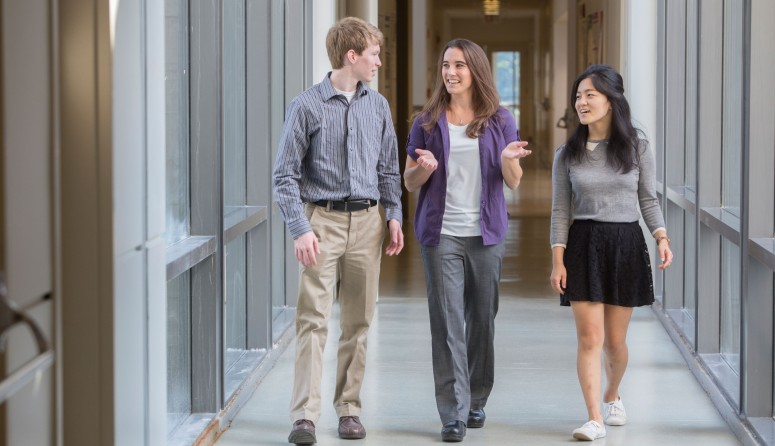Model Research

From Kenyon News - October 16, 2015
No quizzes. No tests. And no right or wrong answers. That’s what students faced in “Mathematical Models,” an upper-level course taught by Assistant Professor of Mathematics Elin Farnell last spring.
She let the class divide into groups and select from two projects: figuring out an optimized staffing plan for a Nationwide call center or determining the shelf life of data verifying information about pharmaceuticals collected by Sproxil, Inc. Both required using mathematical modeling on actual data provided by the companies to come up with solutions. Instead of traditional homework and exams, students were graded on meaningful progress, biweekly communication with company liaisons and final presentations to the businesses at the end of the semester.
“It was just so different from what I had ever done in a class. The biggest thing was we were looking at it as math students. They trained us to look at it as business people,” said Lin Miao ’17, a psychology major and math minor from the Cleveland area who worked on the Sproxil project.
Derek Hoare ’17, a math major from San Clemente, California, who was part of Miao’s team, said he signed up for the course because he was interested in applied mathematics, but he wasn’t sure what to expect. “Traditional math courses are more proof based. You do proofs then present them in class,” he said. “In this class, there weren’t problem sets. You had to be a lot more self-motivated to work on it.”
Farnell said the inspiration for the course came from the Preparation for Industrial Careers Math Program (PIC Math) that encourages college faculty to initiate connections with partners from the business, industry and government communities and to use real problems from those sources as the focus of a semester-long research course. The goal is to make math majors better prepared for careers in industry and more aware of the variety of potential career paths that rely on a strong mathematical foundation. Farnell had used hypothetical situations in previous modeling classes, but never this kind of industry collaboration.
John Zito ’16, a math major from the Cleveland area, said he took the class because it was a research opportunity that isn’t usually covered in a semester-long class. “It was great to do applied math to a real world problem where you can have an impact,” said Zito, who worked on the Nationwide project.
But actual data meant actual problems, too. Students figured out modeling methods to answer questions, but then discovered the methods didn’t yield significant results. They had to find alternative formulas to analyze the data. “It’s an uncomfortable situation for students because the questions are open-ended and it’s often necessary to apply several techniques in order to find meaningful results. But with the open-endedness comes a valuable opportunity to develop problem-solving skills,” Farnell said.
Executing the project was incredibly challenging, Zito said. “The methods we chose were way beyond what I had tried before. Not only did I have to learn new methods, but then find ways to make the methods work.”
Miao agreed that not having one set answer was a particular challenge, but said, “You don’t go into the industry with an answer key and a rubric. You have to try different methods.”
“Welcome to the business world,” laughed Jennifer Campos, director of service innovation at Sproxil, based in Cambridge, Massachusetts. Campos, the company liaison for Farnell’s project, said the class was a learning opportunity for the company, too. “We are not the experts here. It takes a lot of very sophisticated math to look at all of this information.”
She said she was impressed with the students’ approach, particularly the modeling. “We really plan to implement the feedback they give. They’ve made an actual impact on a company.”
Representatives from Columbus, Ohio-based Nationwide said they were looking for more than technical analysis — they wanted solutions. “Their work couldn’t just be technically sound, but it had to be practical,” said Michael McCaslin, executive in residence at the Nationwide Center for Advanced Customer Insights. “We were very impressed by how well they understood the problems. Their outcomes were quite advanced.”
In addition, Nationwide saw its involvement with the class as a way for students to get a taste of careers in data analysis and to introduce them to the corporate culture of a Fortune 100 company.
Experiential learning as a whole has been shown to make students more marketable after graduation. Other high-impact, experiential-learning situations at Kenyon include work with immigrants seeking asylum in “Immigration, Citizenship and National Identity,” a course taught by Nancy Powers, visiting assistant professor of political science, and work on area farms as part of a collaboration between Professor of Biology Siobhan Fennessy, the Philip and Sheila Jordan Professor in Environmental Studies, and Bruce Hardy, the John B. McCoy Bank One Distinguished Teaching Professor of Anthropology.
Farnell maintains that experiential learning is a valuable part of a rigorous liberal arts education. “Ultimately the deepest learning happens when you’re actively engaged with content in a meaningful way,” Farnell said. “Community-engaged learning provides a setting in which students can gain a deep understanding of content while developing important critical thinking, problem-solving and communication skills.”